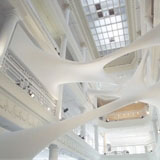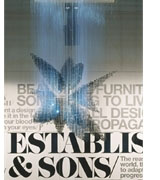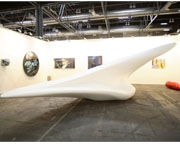Zaha of all trades

Zaha Hadid’s architecture has catapulted her into global superstardom, but she has also been busy designing furniture and exhibitions. Hugh Pearman speaks to her about this lesser known side of her work
Zaha Hadid is now so well known that her surname is slipping out of use. ‘Zaha’ is enough. What other Zahas are there in the world of design and architecture? None that come up on Google, that’s for sure. So her first name alone is a global brand. And when you’re a brand, you add value. Which is why Zaha is as in demand for product and exhibition design as she is for buildings and masterplans.
Go to Zaha Hadid Architects these days and you find no fewer than 136 people/ she has all but taken over the old Clerkenwell school that used to be a shared workspace for lots of different design firms. And like some other internationally known architects – Norman Foster springs to mind – the boss likes the immediacy of designing an object for production. No doubt this is precisely because it is so personal. Hadid likes to be in control more than most. But the bigger you get as a practice, the less direct control one person can have. Product design, being on a smaller scale, can give you back that control.
And, when you’re a brand, one of your products provides a cheaper way for someone to buy into the name. Unless, of course, you are a wealthy New York collector, in which case money is no object. It is already legendary that a prototype Aqua table, as designed by Hadid for Established & Sons, was knocked down at a New York auction for nearly $300 000 (£159 336) at the turn of the year. That tells you all you need to know about the value of the brand.
‘It’s amazing,’ she admits, plainly pleased, but also slightly incredulous. ‘They’re starting to treat editions of designs as art pieces.’ We’re sitting at her meeting-room table in Clerkenwell, which has a top built up of layers of striated blue Perspex, like one of her architectural masterplans. She has been making one-off pieces for years – she had some famously jagged items in her former flat in Chelsea, which led to an early (1985) commission for the interiors of a Modernist home in Cathcart Road. Some of this has now gone off to the Guggenheim Museum in New York for her new one-woman exhibition, opening this Saturday, 3 June.

‘I’ve always been interested in furniture since Cathcart Road,’ says Hadid. ‘At the time, it wasn’t about being domestic furniture, or being office furniture. The question was: how do you occupy a fluid space? What do you do with furniture in non-rectilinear, non-Euclidian space? How do you place a sofa, if the wall is not straight, but all sofas are straight?’
The Bitar furniture that resulted, named after her client, were big pieces that defined the space they were in – such as the Wave sofa, which turned and undulated, switched from hard to soft materials, and had a separate, wall-mounted backrest. But, these days, Hadid is into more technological items. Such as her prototype Z Island kitchen for DuPont Corian, premiered at this year’s Milan Furniture Fair. It comprises two free-standing island units, a modular wall panel system and a shelving system, all in Hadid’s soft-edged fluid mode, inspired by melting ice (‘We have to develop it a bit more,’ she observes). It’s in a similar vein to her interiors at the Hotel Puerto America in Madrid, where she got to do a full floor of 30 rooms, along with a bevy of the world’s other leading architects. There’s even a concept hydrogen-powered car in her portfolio that looks like a 21st century reworking of the 1950s Messerschmitt micro-car, only more articulated – it is short and tall at low speeds in cities, and flattens out to become longer and sleeker at speed. Hadid does not drive: the design is credited to Jens Borstelmann in her office.
More likely to find buyers are desirable take-home objects, such as the stainless steel Crevasse vase for Alessi (a companion to her horizontalist tea and coffee set designed for the last-but-one Venice architecture biennale). Or the illuminated glass fibre-and-acrylic Vortexx chandelier for Sawaya and Moroni, or, of course, the Aqua table, which is a bit cheaper than $300 000 (£159 336) in its production form. This last, as Hadid is happy to admit, is connected with the architecture she was doing at the time. In its sinuous form, and the way its legs and underside are one continuous surface, you find echoes of her Phaeno Science Centre in Wolfsburg and (as the name tells you) her designs for the London Olympic Aquatics Centre.
Then there is the Swarm chandelier, also for Established & Sons. Traditional only in being made of suspended pieces of crystal, it has more in common with a Cornelia Parker installation – particularly in its sense of being a controlled explosion, like Parker’s famous Cold Dark Matter at Tate Modern. It is very, very complex.
At what point does an exhibition design become an art installation? At the Millennium Dome, her Mind Zone could be read as a large, interactive object or a complete building as much as a display medium. No such ambiguity with her Elastika site-specific installation for Art Basel Miami Beach in 2005, where she subverted the atrium of a 1921 building with big stretch-fabric linkages, like giant chewing gum. That was art pure and simple.
The list continues and, as with all Hadid’s projects these days, it becomes hard to keep up with the flood of commissions. But the nature of the work is changing, she points out.

‘The design thing first exploded in the 1980s with all those little objects – lots of people doing teapots and vases. Alessandro Mendini was advising Alessi. Then came Rolf Fehlbaum at Vitra with the chairs. Now the explosion is in big pieces. Sofas, benches, kitchens… it’s very interesting.’
In the end, the thing about Hadid is that she does not make a distinction between one design discipline and another. Her mantra of seamlessness applies to everything. Some see her buildings as sculpture, rather than architecture. This is why her product design commands such high prices. But it also means that she does not design in isolation. Everything fits into a greater, more sinuous environment. You could call it Zaha World.
Zaha Hadid runs from 3 June to 25 October at the Solomon R Guggenheim Museum, 1071 5th Avenue, New York
-
Post a comment



